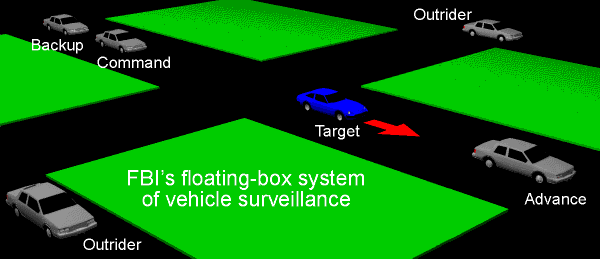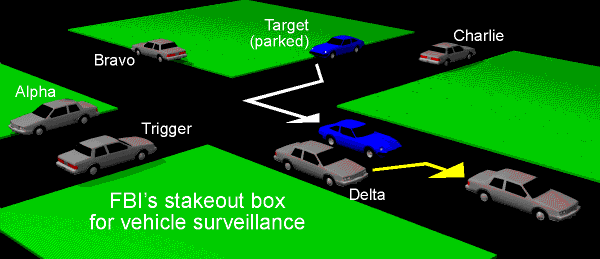
| Smart Browsing Tip – If you arrived at this page from a search engine, you should first go to the Spy & CounterSpy home page, which gives you full access to all the free features at our Web site. |
| Content Warning – This article provides sensitive information to concerned citizens who want to resist government tyranny and repression. If you are a minor or a criminal, please leave now – and don't come back. |
| Downloading Tip – This article
contains images that will help you understand the principles of vehicle
surveillance. The images and text are designed to work together.
Please be patient while the images download.
... |
| ...
... ... |
Vehicle
surveillance: The FBI's system... Part one in a five-part series Copyright ©1998 Lee Adams. All rights reserved. http://www.SPYCOUNTERSPY.com Be sure you read and understand the legal small print concerning this article. Wheel artist – that's spy-talk for an
outdoor surveillance specialist operating in a vehicle. The FBI has lots
of them – agents and bucars (bureau cars). Together they're called vehicle
surveillance teams. |
| ...
... |
The FBI: A dangerous adversary... |
|
The FBI's floating box system... |

|
| The
target's vehicle is shown in blue. The vehicles of the surveillance team
are depicted in gray. The green rectangles represent urban terrain. The illustration is not rendered to scale. Distances in the real world are significantly greater. Furthermore, surveillance vehicles in the real world are never the identical make, model, and color. FBI teams use sedans, coupes, stationwagons, pickup trucks, vans, minivans, sport utility vehicles, taxis, motorcycles, commercial trucks, ambulances, 18-wheelers, and others. ... Specialized roles Each of the surveillance vehicles in the above illustration is charged with carrying out a specific assignment. Command vehicle. The command vehicle is tasked with maintaining visual contact with the target. The agent is said to have command of the target. This is a pivotal role. This agent keeps the other team members informed of the target's direction, speed, intentions, etc. Backup vehicle. The backup vehicle provides a fill-in function. Because the command vehicle is the vehicle most likely to be detected by the target, the FBI has devised a number of strategies that let the backup vehicle take over the command role, thereby allowing the previous command vehicle to exit the surveillance box. Many suspects have been duped by this strategy, as you'll learn later in this article. Advance vehicle. The advance vehicle is like an early warning system. The agent provides advance warning of obstacles, hazards, or traffic conditions that would otherwise catch the surveillance team unaware. The advance vehicle also fulfills another important function. If the FBI has bugged your telephone or your office or your residence, they're likely to already know your destination. Naturally, the advance vehicle arrives before you do. Many suspects have been completely fooled by the undercover FBI agent who is already seated at the restaurant when the suspect arrives. Outrider vehicle. The outrider vehicles patrol the perimeter of the floating-box. Their assignment is to make certain that the target does not get outside the containment of the box. They also play a key role when the target makes a turn at an intersection, as you'll learn later in this article. ... Surveillance advantages The floating-box is a very powerful and flexible system. It allows the FBI to successfully respond to a variety of situations. The FBI is almost never caught off-guard. Recovery from mistakes. If visual contact with the target is lost, the box can be collapsed inward, enabling the agents to quickly re-acquire command of the target. (Whenever the FBI loses visual contact with the target, the surveillance team immediately executes a lost-command drill. The FBI has a number of strategies they use to re-acquire command of the target.) Quick response. The floating-box also allows the FBI to react quickly to a target who is attempting to evade surveillance. If the target unexpectedly makes a left turn, for example, the left outrider vehicle turns left and becomes the new advance vehicle. The other elements in the team shift roles as appropriate. More on this later. Signature shift. The floating-box makes it possible to quickly alter the signature of the team, making them more difficult to detect. In the previous illustration of the floating-box system, there are five surveillance vehicles. At first glance one might assume they can be reconfigured five different ways if they switch roles. In actual practise, a team of five vehicles can be reconfigured 5x4x3x2x1 = 120 different ways. Not all of these configurations are useful in the field, especially when the command vehicle's role is unchanged. In practise, about two dozen configurations are practical – more than enough to deceive most targets. |
|
The FBI's stakeout box... |

|
| The
target's vehicle is shown in blue. The vehicles of the surveillance team
are depicted in gray. The image is not rendered to scale. Distances are
much greater in the real world. ... Assignments Note how vehicles Alpha, Brava, Charlie, and Delta are prepositioned. They are pointed away from the parked target vehicle. Each of these four layup vehicles is ready to initiate a follow, no matter which direction the target takes. Trigger vehicle. The trigger vehicle is responsible for maintaining visual contact with the parked target vehicle. When the target begins to drive away, the agent in the trigger vehicle alerts the other members of the stakeout box. The agent is triggering the rest of the team into action – hence the name, trigger vehicle. Layup vehicle. After being alerted by the trigger vehicle, the appropriate layup vehicle – Alpha, Bravo, Charlie, or Delta – picks up the follow and becomes the command vehicle. The other vehicles assume roles as outriders and backup until the team can be augmented with other FBI vehicles being held in reserve. Picking up the follow. In a smoothly-run stakeout box, the layup vehicle that is initiating the follow will often pull out in front of the target vehicle, as shown in the illustration above. The layup vehicle becomes the command vehicle, with command of the target. When the command vehicle is in front of the moving target vehicle, it is called cheating. A cheating command vehicle is more difficult to detect that a command vehicle that is following the target. |
| ...
... |
Command of the target...
After watching the target make a right
turn at the intersection, the command vehicle continues straight
through the intersection. The agent has, however, alerted one of the layup
vehicles that the FBI has prepositioned at major decision points
along the target's route.
A hard target, however, will eventually
notice a telltale pattern of vehicles on side streets who pull away
from the curb and turn the corner in front of him. (This is how you detect
surveillance teams – by watching for patterns of behavior around you.)
The commit vehicle is prepositioned
at a major decision point along the target's route. The FBI agent
in the commit vehicle is charged with watching the approaching target vehicle.
His assignment is to observe when the target has committed himself to a
specific route. Hence the name commit vehicle. Because he is parked
in a parking lot, driveway, or side street, his presence is difficult to
detect by the target. |
|
Coming up in Article #2... |
|
Coming up in Article #3... |
|
Coming up in Article #4... |
|
Coming up in Article #5... |
| ...
... ... |
... |
|
|
| ...
Spy school for the rest of us. |
| Back to Home Page |
| ... Here is the small print. It appears here because we have found that maintaining a corporate front is the only way we can protect ourselves against interference by governments and their agencies. The legal underpinnings of our corporate front are our first line of defense against audit-attacks and other methods that the authorities use to suppress legitimate dissent, protest, and activism. The authorities are also determined to prove their hypothesis that Spy & CounterSpy is somehow funded by a foreign intelligence agency or terrorist group – but our double entry accounting record of corporate revenue and expenses is our shield against fabricated evidence by an overzealous investigator or case officer. Contents Copyright ©1998 Lee Adams. All rights reserved. Published by Lee Adams Seminars. Provided for research, education, information, and entertainment purposes only. We are not security consultants – we are investigative journalists and survivors of surveillance. Spy & CounterSpy and Spy school for the rest of us and How To Make People Say Yes! are trade-marks in USA, Canada, and/or other countries. Lee Adams Seminars is a division of Here's-how, Right-now! Seminars Inc. OFFICE: 3273 Tennyson Avenue, Victoria, British Columbia, Canada. MAIL: PO Box 8026, Victoria BC, CANADA V8W 3R7. TELEPHONE: (250) 475-1450. FAX: (250) 475-1460. EMAIL: reader_service@SPYCOUNTERSPY.com WEB SITE: http://www.SPYCOUNTERSPY.com License and Limited Warranty |